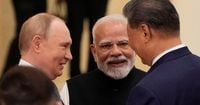In a striking display of shifting alliances and global maneuvering, Indian Prime Minister Narendra Modi and Chinese President Xi Jinping met in Tianjin over the weekend, marking the most significant outcome of the Shanghai Cooperation Organization (SCO) summit held just before September 1, 2025. The timing of the meeting, as noted by Jeremy Chan of Eurasia Group in comments to CNBC, could not have been more consequential. With the Trump administration in Washington imposing steep tariffs on Indian imports and India refusing to bow to American pressure over its Russian oil purchases, the two Asian giants have seized the moment to recalibrate their relationship—and, in the process, send a pointed message to the United States.
Just months ago, India and Pakistan had been locked in a brief but deadly conflict, one that saw China indirectly involved as Pakistan’s military leaned heavily on Beijing-supplied equipment and even received “live inputs” on Indian positions, according to a senior Indian army officer cited by BBC. The fallout from this episode left many in Delhi questioning whether rapprochement with China was even possible. Yet, as global circumstances shifted, so too did diplomatic priorities.
According to BBC, the Trump administration’s decision to slap 50% tariffs on Indian imports in 2025—punishing India for its steadfastness in continuing to buy oil from Russia—created a seismic shift in New Delhi’s foreign policy calculus. India, with its tradition of “strategic autonomy,” faced two clear paths: capitulate to Washington’s demands or double down on its own interests. True to form, Prime Minister Modi chose the latter, refusing to abandon Russian oil, a move that reinforced his strongman image and India’s independent streak on the world stage.
Against this backdrop, Modi’s meeting with Xi took on added significance. The summit, as NBC News reported, brought together not just India and China but also Russian President Vladimir Putin, who was seen holding hands with Modi ahead of the trilateral discussions. Other SCO member states—Turkey, Saudi Arabia, Iran, Qatar, Egypt, and Pakistan—rounded out a formidable roster, underscoring the event’s geopolitical heft.
While the official statements from Beijing and Delhi were light on specifics, they did yield some tangible outcomes. Most immediately, both sides agreed to resume direct flights between India and China and to simplify the process for issuing visas, a move that could help thaw years of diplomatic frost. Yet, as BBC emphasized, the real test lies in whether these gestures can translate into deeper engagement, given the extensive baggage of recent years.
Indeed, the border remains the most persistent source of friction. Tens of thousands of troops from both countries are still deployed along their contested frontier, a legacy of the violent 2020 clashes that derailed years of Modi’s personal investment in the relationship. Ongoing talks between military and civilian leaders aim to reduce tensions, with China’s Defense Ministry recently touting “win-win cooperation” and celebrating the 75th anniversary of diplomatic ties. But as any observer knows, such optimism is tempered by the realities on the ground.
Trade is another sticking point. India’s trade deficit with China has ballooned to over $99 billion, according to 2025 figures cited by BBC. While Beijing would like India to open its vast market further to Chinese goods, Delhi remains wary, insisting that any progress on trade must address the yawning imbalance. Both countries maintain high tariffs and duties in key sectors, reflecting not just economic rivalry but also deep-seated mistrust.
Yet, the symbolism of the meeting—Modi and Xi shaking hands as Trump’s tariffs bite into India’s economy—was not lost on analysts or the public. As Jeremy Chan told CNBC, the encounter sent a clear signal to Washington: India has options. In an era where the relevance of the SCO has grown in response to U.S. policies, the Modi-Xi summit demonstrated that New Delhi is not beholden to any one power, but rather is actively cultivating a web of relationships to maximize its strategic autonomy.
This approach, however, carries its own set of challenges. Later this year, India is scheduled to host the Quad summit, which includes Japan, Australia, and the United States—a grouping widely viewed as a counterweight to China’s influence in the Indo-Pacific. Should former President Trump attend and make anti-China remarks, the renewed warmth between Delhi and Beijing could be put to an immediate test. India’s participation in other multilateral forums perceived as anti-China or anti-Russia further complicates the diplomatic dance.
Meanwhile, India-U.S. relations are at a historic low. The tariffs have stung, and divergent positions on the Russia-Ukraine conflict have only deepened the rift. In fact, a Trump aide recently referred to the Ukraine war as “Modi’s war,” a characterization Delhi has firmly rejected. Despite these tensions, India has refrained from retaliating with its own tariffs, keeping the door open for future negotiations. As BBC noted, the U.S. remains India’s largest trading partner, a fact that tempers even the most assertive gestures toward Beijing.
From China’s perspective, the timing could hardly be better. President Xi’s oft-repeated metaphor that “the dragon and the elephant should come together” was on full display, with Chinese officials eager to showcase the benefits of partnership during what Xi called a “period of transformation.” The SCO summit, featuring a parade of global heavyweights and a grand display of military might in Beijing, provided the perfect stage for Xi to signal China’s readiness to repair ties with India—and, by extension, challenge the narrative of U.S. primacy.
The meeting was not just about optics. As Jeremy Chan highlighted, it was the “most important outcome” of the entire SCO summit, demonstrating that the organization’s prominence has evolved in direct response to American actions. For India, the outreach to China may have been accelerated by Trump’s tariffs, but the underlying drivers—economic pragmatism, security concerns, and a desire for autonomy—remain unchanged.
Still, the road ahead is anything but smooth. The border dispute, the trade deficit, and mutual suspicions will not disappear overnight. And with the Quad summit looming, India’s ability to balance its relationships with both China and the United States will be put to the test. As BBC put it, “Will going closer to China help India’s negotiations with the US or will it have the opposite impact?” That question is likely to dominate strategic discussions in Delhi—and beyond—for months to come.
For now, the Modi-Xi meeting stands as a vivid illustration of how global power dynamics are in flux. In a world where alliances can shift overnight and economic interests often trump old loyalties, India and China have shown that even the most fraught relationships can find new purpose when the stakes are high enough.





